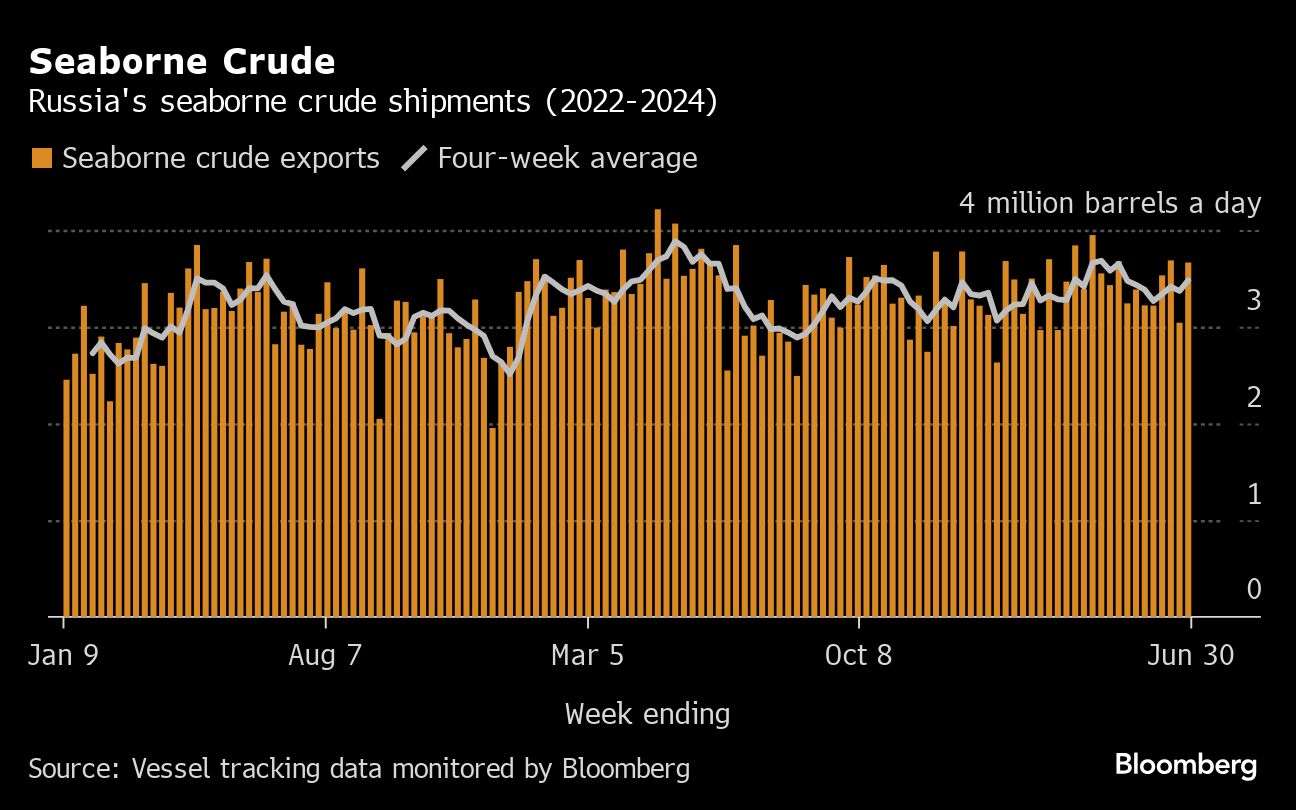
RUSSIA’S SEABORNE CRUDE SHIPMENTS REBOUND TO HIGHEST SINCE MAY
(Bloomberg) -- Russia’s weekly crude exports jumped by the most since March in the seven days to June 30 on completion of maintenance at major export terminals, with the less volatile four-week average rising to its highest in eight weeks.
Work affecting Primorsk on the Baltic Sea and Kozmino on the Pacific coast cut shipments through Russia’s two busiest oil terminals in the previous week, with no departures from either for four days during that period. But flows from both recovered fully in the most recent week.
Overseas shipments may have been boosted by a slump in crude processing, with refinery runs in the June 1-26 period the lowest since May 2022, as Ukrainian drone strikes and seasonal maintenance curbed operations.
The gross value of Russia’s crude shipments soared by 25% in the seven days to June 30, with the jump in weekly export volumes boosted by a third straight week-on-week increase in oil prices, which lifted the value of Russian export grades to their highest since April.
Separately, vessels targeted by Western authorities that Moscow relies on to transport its oil are mostly remaining idle after being sanctioned. While three of the 21 ships owned by Russia’s state-controlled Sovcomflot PJSC have taken on cargoes and subsequently disappeared from automated tracking systems, others remain inactive.
All three crude tankers sanctioned by the UK on June 13 remain anchored off Ust-Luga oil terminal, despite earlier featuring in loading programs for Russia’s Baltic ports. It is unclear whether they will actually take on cargoes, though, with all now having disappeared from partial line-ups seen by Bloomberg. Similarly, none of the crude carriers sanctioned by the European Union has loaded a cargo since the directive was published on June 25.
Crude Shipments
A total of 34 tankers loaded 25.66 million barrels of Russian crude in the week to June 30, vessel-tracking data and port agent reports show. That was a sharp rebound from 21.29 million barrels the previous week, after port work ended.
Russia’s seaborne crude flows in the week to June 30 rose by about 620,000 barrels a day to 3.67 million, recovering virtually all of the previous week’s loss. The less volatile four-week average was also up, rising by about 110,000 barrels a day to an eight-week high of 3.48 million.
The previous week’s slump in shipments from Primorsk and Kozmino — Russia’s two most important crude export ports — was fully reversed, but partly offset by fewer ships leaving Novorossiysk and the Arctic terminals at Murmansk.
Shipments from Sakhalin Island are still not running smoothly, with one tanker appearing fully loaded, but still anchored off the terminal and a second anchored partly full.
After last week’s jump, crude shipments so far this year are running about 20,000 barrels a day above the average for the whole of 2023.
Russia terminated its export targets at the end of May, opting instead to restrict production, in line with its partners in the OPEC+ oil producers’ group. The country’s output target is set at 8.978 million barrels a day until the end of September, after which it is scheduled to rise at a rate of 39,000 barrels a day each month until September 2025, as long as market conditions allow.
Two cargoes of Kazakhstan’s KEBCO were loaded at Novorossiysk and one at Ust-Luga during the week.
Flows by Destination
Asia
Observed shipments to Russia’s Asian customers, including those showing no final destination, rose to a seven-week high of 3.04 million barrels a day in the four weeks to June 30.
About 1.11 million barrels a day of crude was loaded onto tankers heading to China. The Asian nation’s seaborne imports are boosted by about 800,000 barrels a day of crude delivered from Russia by pipeline, either directly, or via Kazakhstan.
Flows on ships signaling destinations in India averaged about 1.61 million barrels a day, down from the revised figure of 1.8 million for the period to June 23.
Both the Chinese and Indian figures are likely to rise as the discharge ports become clear for vessels that are not currently showing final destinations.
The equivalent of about 265,000 barrels a day was on vessels signaling Port Said or Suez in Egypt. Those voyages typically end at ports in India or China and show up as “Unknown Asia” until a final destination becomes apparent.
The “Other Unknown” volumes, running at about 50,000 barrels a day in the four weeks to June 30, are those on tankers showing no clear destination. Most originate from Russia’s western ports and go on to transit the Suez Canal, but some could end up in Turkey. Others may be moved from one vessel to another, with the majority of such transfers now taking place in the Mediterranean, most recently off Morocco, or near Sohar in Oman.
Russia’s oil flows continue to be complicated by the Greek navy carrying out exercises in an area that’s become synonymous with the transfer of the nation’s crude. These activities have now been extended to July 15.
Europe and Turkey
Russia’s seaborne crude exports to European countries have ceased, with flows to Bulgaria halted at the end of last year. Moscow also lost about 500,000 barrels a day of pipeline exports to Poland and Germany at the start of 2023, when those countries stopped purchases.
Turkey is now the only short-haul market for shipments from Russia’s western ports, with flows in the 28 days to June 30 edging up to about 440,000 barrels a day, equaling the highest level seen in detailed tracking data that go back to the start of 2022, before Russia’s invasion of Ukraine.
Export Value
The gross value of Russia’s crude exports rose to $1.92 billion in the seven days to June 30 from about $1.54 billion in the period to June 23. The jump in flows was boosted by a week-on-week increases in prices for Russia’s major crude streams to take gross revenues to their highest in 11 weeks.
Export values at Baltic ports were up week-on-week by almost $1.30 a barrel, while key Pacific grade ESPO rose by about $1.20 a barrel. The price of crude shipped from Novorossiysk rose by $1.60 a barrel. Delivered prices in India also increased, up by about $1.10 a barrel, all according to numbers from Argus Media.
Four-week average income was also up, rising by about $90 million to $1.72 billion a week. The four-week average peak of $2.17 billion a week was reached in the period to June 19, 2022.
During the first four weeks after the Group of Seven nations’ price cap on Russian crude exports came into effect in early December 2022, the value of seaborne flows fell to a low of $930 million a week, but soon recovered.
NOTES
This story forms part of a weekly series tracking shipments of crude from Russian export terminals and the gross value of those flows. The next update will be on Tuesday, July 9.
All figures exclude cargoes identified as Kazakhstan’s KEBCO grade. Those are shipments made by KazTransoil JSC that transit Russia for export through Novorossiysk and Ust-Luga and are not subject to European Union sanctions or a price cap. The Kazakh barrels are blended with crude of Russian origin to create a uniform export stream. Since Russia’s invasion of Ukraine, Kazakhstan has rebranded its cargoes to distinguish them from those shipped by Russian companies.
Vessel-tracking data are cross-checked against port agent reports as well as flows and ship movements reported by other information providers including Kpler and Vortexa Ltd.
If you are reading this story on the Bloomberg terminal, click for a link to a PDF file of four-week average flows from Russia to key destinations.
--With assistance from Sherry Su.
More stories like this are available on bloomberg.com
©2024 Bloomberg L.P.
2024-07-02T12:04:16Z dg43tfdfdgfd











